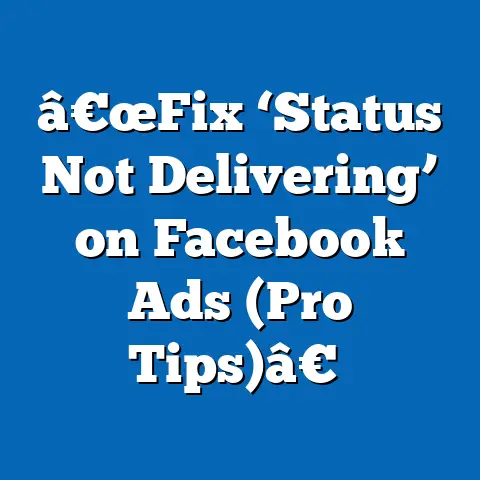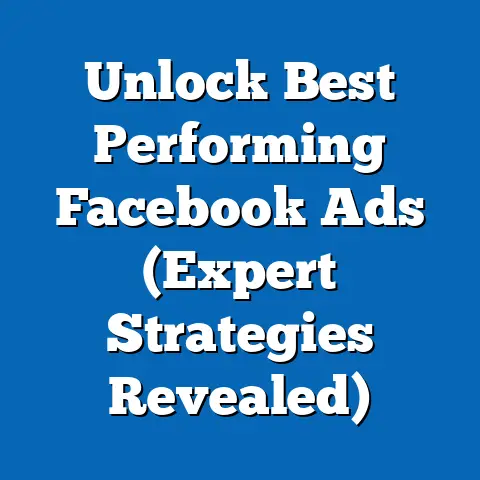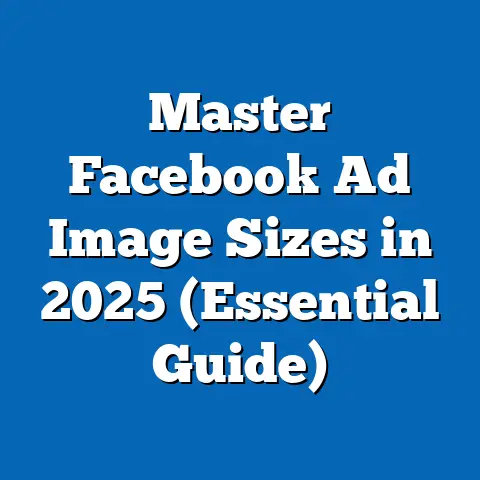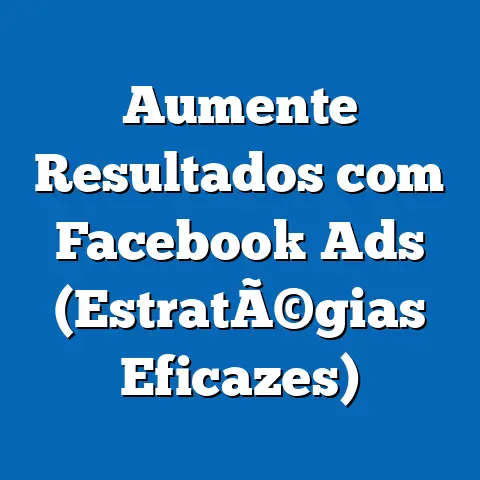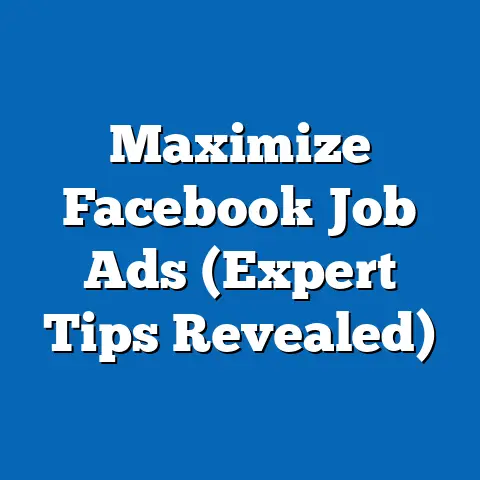Maximize Reach: Multiple Audiences for Facebook Ads (Pro Tips)
Imagine you’re about to launch a groundbreaking new product. It’s a game-changer, something that could really shake up the industry. You’ve got a limited budget, a ticking clock, and the burning desire to reach as many potential customers as possible. You’re faced with a choice: do you cast a wide net, targeting a single, broad audience, or do you meticulously segment your strategy, crafting tailored messages for multiple, more specific groups? Which path leads to better results? What hidden factors might tip the scales?
This is the question that keeps marketers up at night. In this article, I’m going to dive deep into the powerful world of targeting multiple audiences on Facebook. I’ll share pro tips, hard-won insights, and real-world examples to help you maximize your reach, boost engagement, and ultimately, achieve your advertising goals. I’ve personally seen the transformative power of a well-segmented audience strategy, and I’m excited to share my knowledge with you.
Understanding Facebook Audiences: The Foundation of Success
Before we jump into the strategies, let’s lay the groundwork by understanding the different types of audiences you can create within Facebook Ads Manager.
The Importance of Audience Targeting
In the noisy world of digital marketing, where attention spans are shorter than ever, audience targeting isn’t just important – it’s essential. Think of it like this: you wouldn’t try to sell snow shovels in Miami, right? Similarly, showing the wrong ad to the wrong person is a waste of time, money, and potential.
Facebook’s ad platform is a powerhouse because it allows you to laser-focus your message on the people most likely to be interested in what you have to offer. This means higher conversion rates, lower ad costs, and a more effective overall campaign. I’ve seen campaigns go from struggling to thriving simply by refining the audience targeting.
Types of Audiences in Facebook Ads
Facebook offers three main types of audiences, each with its own strengths and use cases:
Core Audiences: The Building Blocks
Core Audiences are the foundation of Facebook targeting. They allow you to define your audience based on:
- Demographics: Age, gender, education, relationship status, job title, and more. This is basic, but powerful. For instance, if I’m selling a skincare product specifically for men over 40, demographic targeting is my first stop.
- Interests: Hobbies, passions, activities, pages they’ve liked, and topics they follow. This is where you can really hone in on what people are interested in. Let’s say I’m advertising a new hiking backpack; I’d target people interested in hiking, camping, outdoor recreation, and specific hiking brands.
- Behaviors: Past purchase behavior, device usage, travel habits, and other activities on and off Facebook. This is incredibly valuable because it taps into real-world actions. Targeting people who have recently purchased running shoes online, for example, is a great way to reach potential customers for a new running app.
- Location: Target people by country, state, city, zip code, or even a radius around a specific location. This is crucial for local businesses. If I’m running a promotion for my pizza shop, I’ll target people within a 5-mile radius.
Takeaway: Core Audiences are your starting point. They allow you to define your ideal customer based on a wide range of characteristics. Play around with different combinations to find the sweet spot.
Custom Audiences: Leveraging Your Existing Data
Custom Audiences are where things get really interesting. They allow you to upload your own data and create audiences based on:
- Customer Lists: Upload a list of email addresses, phone numbers, or Facebook IDs to target your existing customers. This is fantastic for re-engaging past buyers, promoting new products to loyal fans, or even suppressing existing customers from seeing acquisition-focused ads. One time, I used a customer list to offer an exclusive discount to previous buyers, and it resulted in a huge spike in sales.
- Website Traffic: Use the Facebook Pixel to track visitors to your website and create audiences based on their behavior. You can target people who visited specific pages, spent a certain amount of time on your site, or added items to their cart but didn’t complete the purchase. This is incredibly powerful for retargeting. If someone spends 10 minutes browsing my product catalog but doesn’t buy anything, I’ll retarget them with a special offer.
- App Activity: Target people who have downloaded and used your mobile app. You can target users based on specific actions they’ve taken within the app. Let’s say I have a fitness app; I can target users who have completed at least five workouts in the last month with a promotion for premium features.
- Engagement: Create audiences based on people who have interacted with your content on Facebook or Instagram. This includes people who have liked your page, watched your videos, filled out a lead form, or attended an event. This is a great way to build relationships with people who are already engaged with your brand. I once ran a campaign targeting people who had watched at least 50% of a video ad, and it generated a surprisingly high conversion rate.
Takeaway: Custom Audiences allow you to leverage your existing data to create highly targeted and personalized advertising experiences. This is a must-use strategy for any serious advertiser.
Lookalike Audiences: Finding New Customers Who Look Like Your Best
Lookalike Audiences are Facebook’s secret weapon for finding new customers. They allow you to upload a source audience (e.g., your customer list, website visitors, or page fans) and have Facebook find people who share similar characteristics and behaviors.
- Source Audience: This is the foundation of your Lookalike Audience. Choose a high-quality source audience, such as your top-spending customers or website visitors who have completed a purchase.
- Lookalike Percentage: Choose the size of your Lookalike Audience, ranging from 1% to 10% of the total population in a given country. A smaller percentage (e.g., 1%) will result in a more targeted audience that closely resembles your source audience. A larger percentage (e.g., 10%) will result in a broader audience with potentially higher reach.
- Multiple Lookalike Audiences: You can create multiple Lookalike Audiences based on the same source audience, each with a different percentage. This allows you to test different levels of targeting and optimize your campaigns accordingly.
Takeaway: Lookalike Audiences are a fantastic way to expand your reach and find new customers who are likely to be interested in your products or services. Experiment with different source audiences and lookalike percentages to find the most effective combination.
The Benefits of Targeting Multiple Audiences: A Strategic Advantage
Now that we’ve covered the different types of audiences, let’s explore why targeting multiple audiences is often a superior strategy to targeting a single, broad audience.
Enhanced Reach and Engagement: Going Beyond the Obvious
Targeting multiple audiences isn’t just about reaching more people; it’s about reaching the right people with the right message. By segmenting your audience, you can create ads that resonate more deeply with each group, leading to higher engagement rates and a more effective overall campaign.
Imagine I’m launching a new line of organic baby food. I could target a broad audience of “parents,” but that’s not very specific. Instead, I might create three separate audiences:
- New Parents (0-6 months): These parents are likely overwhelmed and looking for convenient and healthy food options.
- Parents of Toddlers (1-3 years): These parents are looking for nutritious snacks and meals that their toddlers will actually eat.
- Eco-Conscious Parents: These parents are particularly interested in organic and sustainable products.
By tailoring my messaging to each of these groups, I can significantly increase my chances of capturing their attention and driving conversions.
Diverse Messaging Strategies: Speaking Their Language
One of the biggest benefits of targeting multiple audiences is the ability to tailor your messaging to each segment. What resonates with one group might fall flat with another.
Think about it: a teenager will respond differently to an ad than a senior citizen. A busy professional will have different needs and priorities than a stay-at-home parent.
By understanding the unique characteristics and motivations of each audience segment, you can craft messaging that speaks directly to their needs and desires. This can involve using different language, imagery, and calls to action.
For instance, if I’m selling a project management software, I might use the following messaging strategies:
- Small Business Owners: Focus on affordability, ease of use, and time savings.
- Enterprise-Level Companies: Emphasize scalability, security, and integration with existing systems.
- Freelancers: Highlight collaboration features, organization tools, and the ability to manage multiple projects.
Takeaway: Don’t try to be everything to everyone. Tailor your messaging to each audience segment to maximize its impact.
Data-Driven Insights: The Power of Segmentation
Targeting multiple audiences provides a wealth of data that can inform your future marketing strategies. By tracking the performance of each audience segment, you can identify what’s working and what’s not.
This data can help you:
- Optimize your targeting: Identify which audience segments are most responsive and focus your resources on those groups.
- Refine your messaging: Discover which messages resonate most strongly with each audience segment and adjust your copy and creative accordingly.
- Improve your product: Gather feedback from different audience segments and use that information to improve your product or service.
I once ran a campaign targeting two different age groups: 18-24 and 25-34. I discovered that the 18-24 group was much more responsive to video ads, while the 25-34 group preferred image ads. Based on this data, I shifted my strategy to focus on video ads for the younger group and image ads for the older group, which resulted in a significant increase in conversions.
Takeaway: Targeting multiple audiences isn’t just about reaching more people; it’s about gathering valuable data that can help you optimize your marketing efforts and improve your overall business strategy.
Pro Tips for Maximizing Reach with Multiple Audiences: The Advanced Playbook
Now that you understand the benefits of targeting multiple audiences, let’s dive into some pro tips to help you maximize your reach and achieve your advertising goals.
Segmentation Strategies: Finding Your Niche
Effective audience segmentation is the key to unlocking the power of multiple audiences. Here are some strategies to consider:
- Demographic Segmentation: Segment your audience based on age, gender, location, education, income, and other demographic factors. This is a good starting point for most campaigns.
- Interest-Based Segmentation: Segment your audience based on their interests, hobbies, and passions. This is particularly effective for products or services that cater to specific niches.
- Behavioral Segmentation: Segment your audience based on their past behavior, such as purchase history, website activity, and app usage. This is a powerful way to target people who are already interested in your products or services.
- Psychographic Segmentation: Segment your audience based on their values, attitudes, and lifestyles. This can be more challenging to implement, but it can lead to highly targeted and effective campaigns.
Understanding Buyer Personas:
Before you start segmenting your audience, it’s important to understand your ideal customer. Create detailed buyer personas that outline their demographics, interests, behaviors, and motivations. This will help you create more targeted and effective campaigns.
For example, if I’m selling a high-end coffee maker, my buyer persona might look like this:
- Name: Emily
- Age: 35
- Occupation: Marketing Manager
- Income: $80,000 per year
- Interests: Coffee, travel, design, technology
- Motivations: Enjoys high-quality products, values convenience, appreciates aesthetics
By understanding Emily’s needs and desires, I can create ads that resonate with her and convince her to buy my coffee maker.
Takeaway: Effective audience segmentation starts with a deep understanding of your ideal customer. Create detailed buyer personas and use them to guide your targeting strategy.
Utilizing A/B Testing: The Scientific Approach
A/B testing, also known as split testing, is a powerful technique for optimizing your Facebook ad campaigns. It involves creating two or more versions of an ad and showing them to different audience segments to see which performs better.
In the context of multiple audiences, A/B testing can help you:
- Identify the most effective messaging for each audience segment.
- Determine which ad creative resonates most strongly with each group.
- Optimize your bidding strategy for each audience.
How to Set Up A/B Tests:
- Create two or more versions of your ad. Change one element at a time, such as the headline, image, or call to action.
- Target each version of your ad to a different audience segment.
- Track the performance of each ad. Pay attention to metrics such as click-through rate, conversion rate, and cost per acquisition.
- Analyze the results and implement the winning version.
Example:
Let’s say I’m running a campaign to promote a new online course. I could create two versions of my ad:
- Version A: Focuses on the benefits of the course for career advancement.
- Version B: Highlights the personal growth and self-improvement aspects of the course.
I would then target Version A to an audience of young professionals and Version B to an audience of stay-at-home parents. By tracking the performance of each ad, I can determine which message resonates most strongly with each group.
Takeaway: A/B testing is essential for optimizing your Facebook ad campaigns. Use it to test different messaging, creative, and bidding strategies for each audience segment.
Dynamic Ads for Broad Audiences: Personalization at Scale
Dynamic ads are a powerful tool for reaching broad audiences with personalized content. They allow you to automatically show the most relevant products or services to each user based on their past behavior and interests.
For example, if someone visits my website and views a specific product, I can use dynamic ads to retarget them with that product or similar items. This is a highly effective way to drive conversions and increase sales.
How to Implement Dynamic Ads:
- Create a product catalog. This is a spreadsheet or XML file that contains information about your products, such as their name, description, price, and image.
- Upload your product catalog to Facebook.
- Create a dynamic ad campaign.
- Set up your targeting. You can target broad audiences based on their interests, demographics, and behaviors.
- Let Facebook do the rest. Facebook will automatically show the most relevant products to each user based on their past behavior and interests.
Example:
Let’s say I’m selling clothing online. I can use dynamic ads to show users the specific items they’ve viewed on my website, as well as similar products that they might be interested in. This is a much more effective strategy than showing them generic ads for my entire clothing line.
Takeaway: Dynamic ads are a great way to personalize your advertising and reach broad audiences with relevant content.
Retargeting Strategies: Bringing Them Back
Retargeting is a powerful technique for reaching people who have already interacted with your brand. It involves showing ads to people who have visited your website, used your app, or engaged with your content on Facebook or Instagram.
Retargeting is particularly effective for multiple audiences because it allows you to show different ads to different groups of people based on their specific actions.
Examples:
- Website Visitors: Show ads to people who have visited your website but haven’t made a purchase.
- Cart Abandoners: Show ads to people who have added items to their cart but haven’t completed the checkout process. Offer them a discount or free shipping to encourage them to complete their purchase.
- Past Customers: Show ads to people who have purchased from you in the past. Promote new products or services, or offer them a special discount to reward their loyalty.
Frequency Capping and Ad Fatigue:
It’s important to be mindful of frequency capping when running retargeting campaigns. Showing the same ad to the same person too many times can lead to ad fatigue and negative brand perception.
Set a frequency cap to limit the number of times each person sees your ad. A good starting point is 3-5 impressions per week.
Takeaway: Retargeting is a must-use strategy for any serious advertiser. Use it to reach people who have already interacted with your brand and drive conversions.
Utilizing Facebook Insights and Analytics: Tracking Your Progress
Facebook Insights and Analytics are powerful tools for evaluating the performance of your ad campaigns across different audiences. They allow you to track key metrics such as reach, engagement, click-through rate, conversion rate, and cost per acquisition.
By analyzing this data, you can identify which audience segments are most responsive and optimize your campaigns accordingly.
Tips for Using Facebook Insights and Analytics:
- Focus on the metrics that matter most to your business. Are you trying to drive sales, generate leads, or increase brand awareness? Choose the metrics that align with your goals.
- Compare the performance of different audience segments. Which groups are most responsive to your ads? Which groups are generating the most conversions?
- Track your progress over time. Are your campaigns improving? Are you seeing a positive return on investment?
- Use the data to inform your future marketing strategies. What can you learn from your past campaigns? How can you improve your targeting, messaging, and creative?
Takeaway: Facebook Insights and Analytics are essential for tracking the performance of your ad campaigns and making data-driven decisions.
Case Studies and Real-World Examples: Learning from the Best (and the Worst)
Let’s take a look at some real-world examples of businesses that have successfully utilized multiple audience targeting in their Facebook ads.
Success Stories: Inspiration in Action
- Example 1: A Local Restaurant: A local restaurant used demographic targeting to reach people in their area who were interested in food and dining. They also used interest-based targeting to reach people who were interested in specific types of cuisine, such as Italian or Mexican. By tailoring their ads to these different audience segments, they were able to increase their reservations by 20%.
- Example 2: An E-Commerce Store: An e-commerce store used website retargeting to show ads to people who had visited their website but hadn’t made a purchase. They also used cart abandonment retargeting to show ads to people who had added items to their cart but hadn’t completed the checkout process. By offering these customers a discount, they were able to recover 15% of their abandoned carts.
- Example 3: A Software Company: A software company used lookalike audiences to find new customers who were similar to their existing customers. They uploaded a list of their top-spending customers to Facebook and created a lookalike audience based on that list. This strategy helped them increase their lead generation by 30%.
Lessons Learned from Failures: Avoiding Common Pitfalls
- Pitfall 1: Targeting Too Broadly: Targeting a single, broad audience can lead to low engagement and wasted ad spend. It’s important to segment your audience and tailor your messaging to each group.
- Pitfall 2: Ignoring Ad Fatigue: Showing the same ad to the same person too many times can lead to ad fatigue and negative brand perception. Set a frequency cap to limit the number of times each person sees your ad.
- Pitfall 3: Not Tracking Your Results: If you’re not tracking the performance of your ad campaigns, you won’t know what’s working and what’s not. Use Facebook Insights and Analytics to monitor your progress and make data-driven decisions.
- Pitfall 4: Neglecting Mobile Optimization: With the majority of Facebook users accessing the platform on mobile devices, neglecting mobile optimization can severely limit your reach and impact. Ensure your ads are mobile-friendly and that your landing pages are optimized for mobile viewing.
Takeaway: Learn from the successes and failures of others. Pay attention to the case studies and real-world examples in this article and use them to inform your own Facebook advertising strategy.
Conclusion: The Future of Facebook Advertising – It’s All About Personalization
Facebook advertising is constantly evolving. New features and technologies are being introduced all the time. But one thing remains constant: the importance of audience targeting.
In the future, Facebook advertising will become even more personalized. Advertisers will be able to use data to create highly targeted ads that are tailored to the individual needs and interests of each user.
To succeed in this environment, you need to stay adaptable and continuously test new approaches. Experiment with different audience segments, messaging strategies, and ad creative. Track your results and use the data to inform your future marketing strategies.
The key to maximizing your reach on Facebook is to think creatively and continuously test new approaches to reach diverse audiences effectively. By following the pro tips and strategies outlined in this article, you can unlock the power of multiple audience targeting and achieve your advertising goals.
Call to Action: Share Your Experiences and Learn More
Now it’s your turn. I encourage you to share your own experiences with Facebook ads and audience targeting in the comments section below. What strategies have worked for you? What challenges have you faced?
And if you want to learn more about maximizing your marketing strategies, subscribe to my newsletter for more insights, tips, and tricks.
Let’s work together to unlock the full potential of Facebook advertising!

